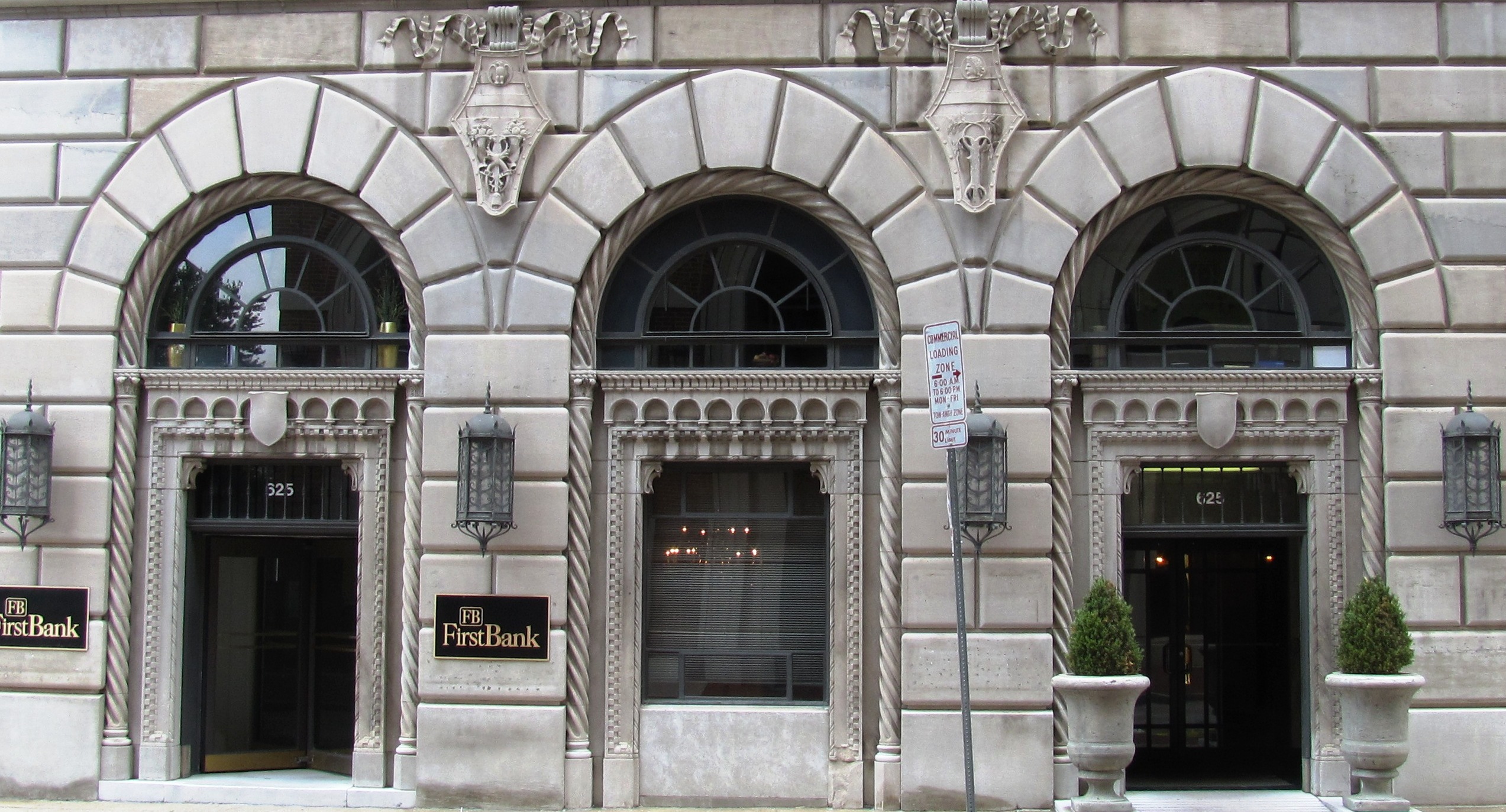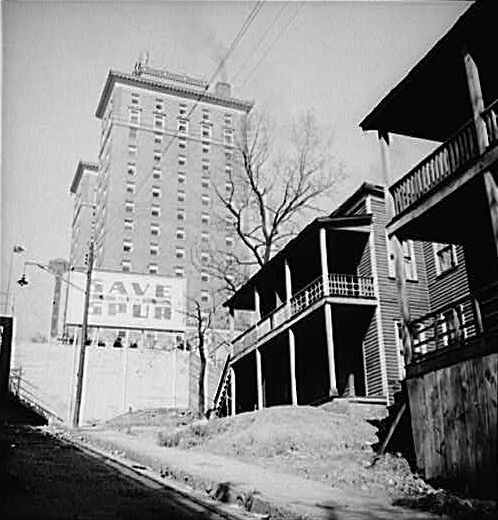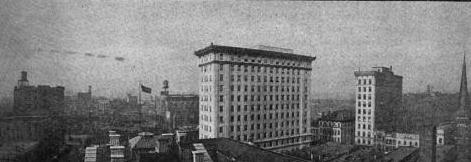|
General Building
The General Building, also called the Tennessee General Building or the First Bank Building, is an office high-rise located in downtown Knoxville, Tennessee, United States. Constructed in 1925, the 14-story building is the only high-rise designed by Charles I. Barber, and has over the years housed the offices of dozens of banks, physicians, and various financial and architectural firms. The Lexington, Tennessee-based First Bank is the current anchor tenant. In 1988, the General Building was listed on the National Register of Historic Places for its architecture and its role in Knoxville's commercial history. Design The General Building is a 14-story "L-shaped" building rising on the northwest corner of Church Avenue and Market Street. By 1958, a four-story annex had been added to the rear of the building, giving the first four stories a square shape, rather than an L-shape. The first three stories of the Church and Market facades are covered with a rusticated limestone vene ... [...More Info...] [...Related Items...] OR: [Wikipedia] [Google] [Baidu] |
Knoxville, Tennessee
Knoxville is a city in and the county seat of Knox County in the U.S. state of Tennessee. As of the 2020 United States census, Knoxville's population was 190,740, making it the largest city in the East Tennessee Grand Division and the state's third largest city after Nashville and Memphis.U.S. Census Bureau2010 Census Interactive Population Search. Retrieved: December 20, 2011. Knoxville is the principal city of the Knoxville Metropolitan Statistical Area, which had an estimated population of 869,046 in 2019. First settled in 1786, Knoxville was the first capital of Tennessee. The city struggled with geographic isolation throughout the early 19th century. The arrival of the railroad in 1855 led to an economic boom. The city was bitterly divided over the secession issue during the American Civil War and was occupied alternately by Confederate and Union armies, culminating in the Battle of Fort Sanders in 1863. Following the war, Knoxville grew rapidly as a major whole ... [...More Info...] [...Related Items...] OR: [Wikipedia] [Google] [Baidu] |
Charles McClung
Charles McClung (May 13, 1761 – August 9, 1835) was an American pioneer, politician, and surveyor best known for drawing up the original plat of Knoxville, Tennessee, in 1791. While Knoxville has since expanded to many times its original size, the city's downtown area still roughly follows McClung's 1791 grid. McClung also helped draft Tennessee's constitution in 1796, surveyed and planned what is now Kingston Pike in 1792, and served as Knox County's first court clerk. His home, Statesview, still stands in West Knoxville, and has been listed on the National Register of Historic Places.East Tennessee Historical Society, Mary Rothrock (ed.), ''The French Broad-Holston Country: A History of Knox County, Tennessee'' (Knoxville, Tenn.: The Society, 1972), pp. 446-7. Biography Early life McClung was born in Lancaster County, Pennsylvania, to Matthew McClung and Martha Cunningham McClung, both of Scots-Irish descent. McClung later claimed that due to his mechanical aptit ... [...More Info...] [...Related Items...] OR: [Wikipedia] [Google] [Baidu] |
Buildings And Structures Completed In 1925
A building, or edifice, is an enclosed structure with a roof and walls standing more or less permanently in one place, such as a house or factory (although there's also portable buildings). Buildings come in a variety of sizes, shapes, and functions, and have been adapted throughout history for a wide number of factors, from building materials available, to weather conditions, land prices, ground conditions, specific uses, prestige, and aesthetic reasons. To better understand the term ''building'' compare the list of nonbuilding structures. Buildings serve several societal needs – primarily as shelter from weather, security, living space, privacy, to store belongings, and to comfortably live and work. A building as a shelter represents a physical division of the human habitat (a place of comfort and safety) and the ''outside'' (a place that at times may be harsh and harmful). Ever since the first cave paintings, buildings have also become objects or canvasses of much artist ... [...More Info...] [...Related Items...] OR: [Wikipedia] [Google] [Baidu] |
Skyscrapers In Knoxville, Tennessee
A skyscraper is a tall continuously habitable building having multiple floors. Modern sources currently define skyscrapers as being at least or in height, though there is no universally accepted definition. Skyscrapers are very tall high-rise buildings. Historically, the term first referred to buildings with between 10 and 20 stories when these types of buildings began to be constructed in the 1880s. Skyscrapers may host offices, hotels, residential spaces, and retail spaces. One common feature of skyscrapers is having a steel frame that supports curtain walls. These curtain walls either bear on the framework below or are suspended from the framework above, rather than resting on load-bearing walls of conventional construction. Some early skyscrapers have a steel frame that enables the construction of load-bearing walls taller than of those made of reinforced concrete. Modern skyscrapers' walls are not load-bearing, and most skyscrapers are characterised by large surface ... [...More Info...] [...Related Items...] OR: [Wikipedia] [Google] [Baidu] |
Office Buildings On The National Register Of Historic Places In Tennessee
An office is a space where an organization's employees perform administrative work in order to support and realize objects and goals of the organization. The word "office" may also denote a position within an organization with specific duties attached to it (see officer, office-holder, official); the latter is in fact an earlier usage, office as place originally referring to the location of one's duty. When used as an adjective, the term "office" may refer to business-related tasks. In law, a company or organization has offices in any place where it has an official presence, even if that presence consists of (for example) a storage silo rather than an establishment with desk-and-chair. An office is also an architectural and design phenomenon: ranging from a small office such as a bench in the corner of a small business of extremely small size (see small office/home office), through entire floors of buildings, up to and including massive buildings dedicated entirely to ... [...More Info...] [...Related Items...] OR: [Wikipedia] [Google] [Baidu] |
Medical Arts Building (Knoxville, Tennessee)
The Medical Arts Building is an office high-rise located at 603 Main Street in Knoxville, Tennessee, United States. Completed in 1931, the 10-story structure originally provided office space for physicians and dentists, and at the time was considered the "best equipped" medical building in the South. The building has been listed on the National Register of Historic Places as one of the region's best examples of a Gothic Revival-style office building. It has recently been renovated into mixed-use, principally residential use. History The lot on which the Medical Arts Building stands was originally located just outside Charles McClung's 1791 plat of Knoxville, though the lot had been incorporated into the city by 1795. By the late 19th century, the elaborate Victorian residence of pharmaceutical magnate A. J. Albers stood on the lot. The home of artist Charles Krutch once stood in the parking lot adjacent to the building.Don Williams, "A Walk On the Wild Side of Knoxville Histo ... [...More Info...] [...Related Items...] OR: [Wikipedia] [Google] [Baidu] |
Mechanics' Bank And Trust Company Building
The Mechanics' Bank and Trust Company Building is an office building located at 612 South Gay Street in Knoxville, Tennessee, United States. Built in 1907 for the Mechanics' Bank and Trust Company, the building now houses offices for several law firms and financial agencies. The building's facade was constructed with locally quarried marble, and is designed in the Second Renaissance Revival style. In 1983, the building was added to the National Register of Historic Places for its architectural significance. The Mechanics' National Bank was chartered in 1882, and moved into a building at what is now 612 South Gay that same year. Within a few months of opening, the bank's president, Thomas O'Connor, was killed in a notorious shootout. In 1907, after the bank reorganized as the Mechanics' Bank and Trust, it built the first three floors of the current Mechanics' Bank building. The Union National Bank absorbed Mechanics' Bank in 1922, and added the top two stories the following ... [...More Info...] [...Related Items...] OR: [Wikipedia] [Google] [Baidu] |
Andrew Johnson Building
The Andrew Johnson Building is a high-rise building in downtown Knoxville, Tennessee, United States. Completed in 1929 as the Andrew Johnson Hotel, at , it was Knoxville's tallest building for nearly a half-century.Ronald Childress, National Register of Historic Places Nomination Form for Andrew Johnson Hotel, March 1980, p. 3 In the 1980s, it was converted to office space by Knox County. In 1980, the Andrew Johnson Building was added to the National Register of Historic Places.Ronald Childress, National Register of Historic Places Nomination Form for Andrew Johnson Hotel, March 1980, p. 1 In 2017, BNA Associates announced plans to convert it back to a hotel. The plans were approved in 2020. As of 2022, the county offices have been almost entirely vacated in preparation for the extensive renovations. Named for President Andrew Johnson, the Andrew Johnson Hotel was Knoxville's premier hotel from the time of its completion through the 1960s. In its early years, the hotel was popul ... [...More Info...] [...Related Items...] OR: [Wikipedia] [Google] [Baidu] |
The Holston
The Holston is a condominium high-rise located at 531 South Gay Street in Knoxville, Tennessee, United States. Completed in 1913 as the headquarters for the Holston National Bank, the fourteen-story building was the tallest in Knoxville until the construction in the late 1920s of the Andrew Johnson Hotel, located a few blocks away. The Holston was designed by architect John Kevan Peebles, and today represents the city's only Neoclassical Revival-style high-rise. In 1979, the building was added to the National Register of Historic Places for its architecture and its prominent position in the Knoxville skyline. Founded in 1890, Holston National Bank had grown to become one of Knoxville's three largest banks by 1913, when it built the first twelve stories of the Holston building.East Tennessee Historical Society, Lucile Deaderick (ed.), ''Heart of the Valley: A History of Knoxville, Tennessee'' (Knoxville, Tenn.: East Tennessee Historical Society, 1976), pp. 367-398. The thirtee ... [...More Info...] [...Related Items...] OR: [Wikipedia] [Google] [Baidu] |
BB&T
BB&T Corporation (previously known as the Branch Banking and Trust Company) was one of the largest banking and financial services firms in the United States, based in Winston-Salem, North Carolina. In 2019, BB&T announced its intentions to merge with Atlanta-based SunTrust Banks to form Truist Financial. History In 1872, Alpheus Branch and Thomas Jefferson Hadley founded the Branch and Hadley merchant bank in their hometown of Wilson, North Carolina. After many transactions, mostly with local farmers, Branch bought out Hadley's shares in 1887 and renamed the company Branch and Company, Bankers. During that same year, the bank also moved to its new headquarters on Nash Street in downtown Wilson, North Carolina. Two years later, Branch, his father-in-law Gen. Joshua Barnes, Hadley, and three other men secured a charter from the North Carolina General Assembly to operate the Wilson Banking and Trust Company. After many more name changes, the company finally settled on the name Bran ... [...More Info...] [...Related Items...] OR: [Wikipedia] [Google] [Baidu] |
Church Street Methodist Church (Knoxville, Tennessee)
Church Street United Methodist Church is a United Methodist church located on Henley Street in downtown Knoxville, Tennessee. The church building is considered a Knoxville landmark and is listed on the National Register of Historic Places. History and architecture The Church Street Methodist congregation formed in 1816. Initially, it met in a house on Hill Avenue in downtown Knoxville. In 1836 the congregation moved into a new building on Church Street between Walnut and Market Streets, where it met until 1863 when the building was confiscated by Union troops for use as a hospital during the American Civil War. Around 1870, the congregation relocated to a brick building one block east of its former location on Church Street, and in 1879 it moved into its new Victorian Gothic church building erected on its former 410 Church Street location. Some say this building was designed by Knoxville architect Alexander Campbell Bruce. Planning to replace that church building began in 1921 when ... [...More Info...] [...Related Items...] OR: [Wikipedia] [Google] [Baidu] |
Plat
In the United States, a plat ( or ) (plan) is a cadastral map, drawn to scale, showing the divisions of a piece of land. United States General Land Office surveyors drafted township plats of Public Lands Surveys to show the distance and bearing between section corners, sometimes including topographic or vegetation information. City, town or village plats show subdivisions broken into blocks with streets and alleys. Further refinement often splits blocks into individual lots, usually for the purpose of selling the described lots; this has become known as subdivision. After the filing of a plat, legal descriptions can refer to block and lot-numbers rather than portions of sections. In order for plats to become legally valid, a local governing body, such as a public works department, urban planning commission, or zoning board must normally review and approve them. In gardening history, in both varieties of English (and in French etc), a "plat" means a section of a formal ... [...More Info...] [...Related Items...] OR: [Wikipedia] [Google] [Baidu] |









